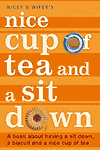Ponghak Butter | | Tuesday 25 Oct 2005 |
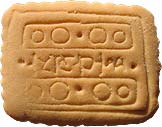 | Yes its time to cast aside thoughts of homely Digestives and generally abandon the carefully laid arrangements for this weeks biscuit, which gets booted to one side to make way for Ponghak. Yes it's the second packet of biscuits to find its way to NCOTAASD HQ from one of the Bush administration's axis of evil countries. All the way from North Korea, courtesy once more of Frazer of blogjam, blogger extraordinare, creator of the Scotch Ostrich-Egg, aka The Ginger Chicken. In fact our first packet of potentially evil biscuits were secured in Faluja by Frazer's sister about two years ago now, and were a perfectly respectable packet of Iraqi Marie Biscuits, which whilst smaller than a Crawfords were fine with a cuppa.
So what passes for biscuits in the Democratic Peoples Republic of Korea? Well of course the first thing of note is that the pack contains biscuits not cookies, obviously leaving the door ajar for Jack Straw rather than Ms Rice to go and have one of his cosy chats.
A quick glance at the somewhat unconventional sachet reveals in perfect English that the ingredients are wheat flour, sugar, butter, egg and condensed milk. It's fair to say at this point that my interest was peaked and my recent traumas with South East Asian biscuits was receding. We also learnt from Frazer that visitors to North Korea have their own shops with their special westernised packs, and the locals have their own shops, neither are allowed to visit the other. However, upon opening the pack a strange piquant doughy smell seeped out. Rather than dissipate the smell just seemed to be gathering itself ready for greater feats such being easily noticeable from the other side of the room. The odd smell did have a ring of distant familiarity, perhaps over ripe flour and water paste from my primary school days. What ever it was, it acted as a fairly powerful appetite suppressant.
Presentation wise the biscuits were gloriously oddly shaped. I would be tempted to say they were hand made had it not been for the fact that they were all the same uniform slightly twisted shape. The impression of the graphic on top looked like it had been the winner in a children's competition to design the top of a biscuit, and was applied in such a way that one corner was barely visible. The biscuit tasted much like any other bland mildly sweet pale biscuit might. It did occur to me that something had been used to raise the dough whilst it baked, although it had not been mentioned on the ingredients. What else weren't they telling us? And just what was that smell?
So it looks very much like the NCOTAASD team will continue with our plans to holiday in France and Ireland, and not be heading to North Korea anytime soon. To find out how Frazer got on in North Korea head over to blogjam.
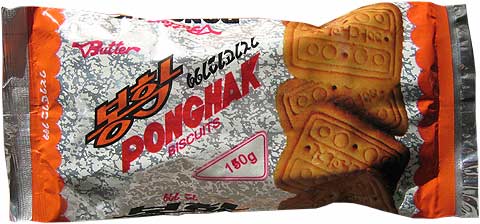
Your feedback 1 message |
| McVities Light Range | | Tuesday 11 Oct 2005 |
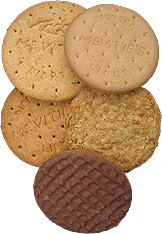 | We often get asked by people which biscuits, if any, can they eat knowing that they are good for you. Of course we have to let down these residents of lu-lu-la-la land gently by reminding them what biscuits are made of. Yummy and delicious come at a price. Yes when you take sugar, fat and flour and some sundry other things you can make delicious biscuits, but it's hardly the profile of a health food. However, if enjoyed in moderation as part of a lifestyle which features regular exercise then for most people that's just fine. Across the broad spectrum of biscuits and related snacks out there, there are going to be all sorts of variations in fat and sugar content. However, a brief glance at our biscuit poll will tell you what most people are eating, and by reformulating these biscuits McVities are helping people to choose a slightly healthier biscuit.
The McVities Light range are 25% fat reduced versions of HobNobs, Digestives, Chocolate Digestives and Rich Tea. I suppose that this is a much better way of expressing it than 'Eat 4 biscuits instead of 3' which is missing the point. Not only is less fat used but its better fat. As we keep saying the hydrogenated fat, the mainstay of the biscuit world till recently has gone. This really is a huge achievement by McVities, and I think they have now ironed out early teething problems with the recipes.
Right I'm going to get unashamedly technical now. The fat content of a biscuit plays a crucial role in both texture and flavour. Certain flavours dissolve into the fat and are carried to the palette most notably the vanilla sort of flavours. As for texture, this really was the main reason for the hydrogenated fat of old. The saturated fat from animals, such as lard and butter are solid at room temperature but melt at body temperature. Bake a biscuit with them and you'll have something with a good snap and short texture softens in the mouth.
Vegetable fats are by and large unsaturated fats which are liquids at room temperature, hence we call them oils. Hydrogenation is an industrial process which chemically alters the fat molecules turning them from an unsaturated fat into a saturated one, something called hardening. Obviously a way to make cheap lard substitutes, but because it's an industrial process the exact melting profile of the resulting fat and therefore the biscuit texture could be finely controlled. The very real problem with all of this was the fact that the process also created exotic fats that wouldn't be found in our natural diet called trans-fats, whose molecules were a different shape to the ones our bodies' chemistry had evolved to deal with. Unfortunately it's not just the fats themselves which harden but also the arteries of those consuming more than the body can cope with.
The responsible parts of the food industry have begun to eliminate the trans-fats from their products and McVities have been quietly leading the way in the mass market biscuit section of the UK market. So has it all been worth it, or have these leaner and undeniably healthier biscuits sacrificed taste along with their dodgy lipids?
Well as far as the Digestive goes, we can all sing hosannah. To my personal taste this is one of the best digestives in a long time. The fat reduction has given the Digestive a real crunch and bite, which I would happily defend against all comers, as being a good thing. The taste is also a bit brighter than before having notes of hard baked crumble topping about it. For those who have also lamented the other healthy revolution of salt reduction in the Digestive, then the reduction in fat will make your tongue think the clock has turned back. I would cheerfully choose this Digestive over its conventional brethren.
As for its chocolate version one gets the sense that we are spectators at the chocolate festival and have been dragged up on stage for five minutes, rather than full time performers. Amazing the difference between the standard 29% chocolate and 24% found here. Also chocolate is one of those flavours which is carried to the tongue by fat, so maybe the explanation is to be found here. Still the I've certainly tasted full fat Chocolate digestives that weren't a patch on this one, so I think you'll find you can quickly make the required adjustment.
Now to the Hobnob. The 25% fat reduced Hobnob is essentially a different biscuit. Here are some of the things that are different, taste, texture and colour. Given all of that we might as well treat it as a new biscuit which slots into the sweet oat bit of the biscuit aisle. I actually liked it, but that's probably no surprise to regulars of the site who know that I enjoy anything with oats in. With oats and wholemeal stepping in to make up the percentages, an earthy wholesome taste and hard bite leave us in no doubt that this is a lean Hobnob. Even the colour seems a bit paler and less golden. However, as I said I like that oaty diversity, and I think that some of you will either like these or possibly run shrieking back to the originals.
As for the rich tea, well they tasted like rich tea. If anybody wants to add to that be my guest.
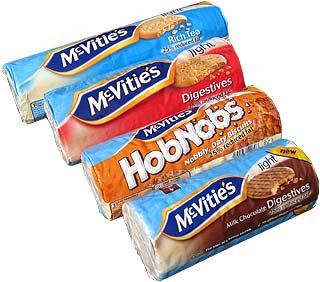
Your feedback 3 messages |
| Fox's Brandysnaps | | Monday 26 Sep 2005 |
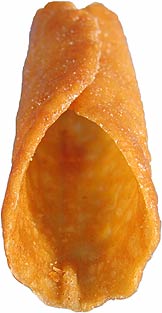 | Look at that Brandysnap, isn't utterly fantastic, all sweet buttery and brittle, just waiting to shatter into a mouthful of delicious little toffee shards! Now I could just leave this weeks review at this point, but one sentence would be a bit on the lean side. Besides if you haven't guessed by now I really, really like Brandysnaps, and feel the need the share that with you.
Fox's actually started out making Brandysnaps back in 1853 in Batley Yorkshire where they are still made today. Given that history lets not get into any silly arguments about who makes proper Brandysnaps. Fox's are the chaps. Instead we should quickly turn our enquiring minds to fact at no point in their recipe does brandy seem to figure. Obviously with a 150 year old biscuit there is plenty of scope for it to have a forgotten past that saw it teaming up Brandy.
Also if we look at the box it seems that rather than pour ourselves an enormous glass of Courvoiuser put our feet up and begin to polish of the contents we are more encouraged to use them to create desserts. Raspberries and cream abound, and one is even to seen poking out of a sundae at forty five degrees. No doubt this is all very delicious, but certainly we have always viewed the Brandysnap as too precious to muck about embroiling it some dessert. No I would much rather deal with them on a fairly one to one basis, although if they did bring along two or three of their friends that would be just fine.
So what exactly is a Brandysnap? Well it can be thought of as the missing link between ginger biscuits and toffee, the hard brittle stuff. The main ingredients are sugar, flour, butter oil and a little bit of ground ginger. When baked the mixture forms thin discs of bubbly toffee. As these cool and before they have hardened they are wrapped around something approximating to the handle of a wooden spoon. This gives them their distinctive tube shape. It also means that they are about as fragile as it possible for a biscuit to be. A company of Brandysnaps requires a great deal of packing just to ensure that a few of their number arrive at your table unscathed. In fact our review box which was the last one on the shelf contained only two intact Brandysnaps out of the complement of eight. It also illustrates how popular this old favourite is especially amongst the forward thinking people at this time of year. If you did follow that last comment, then your Christmas's at your grannies must have been quite different to mine.
Your feedback 2 messages |
| |
|
|
